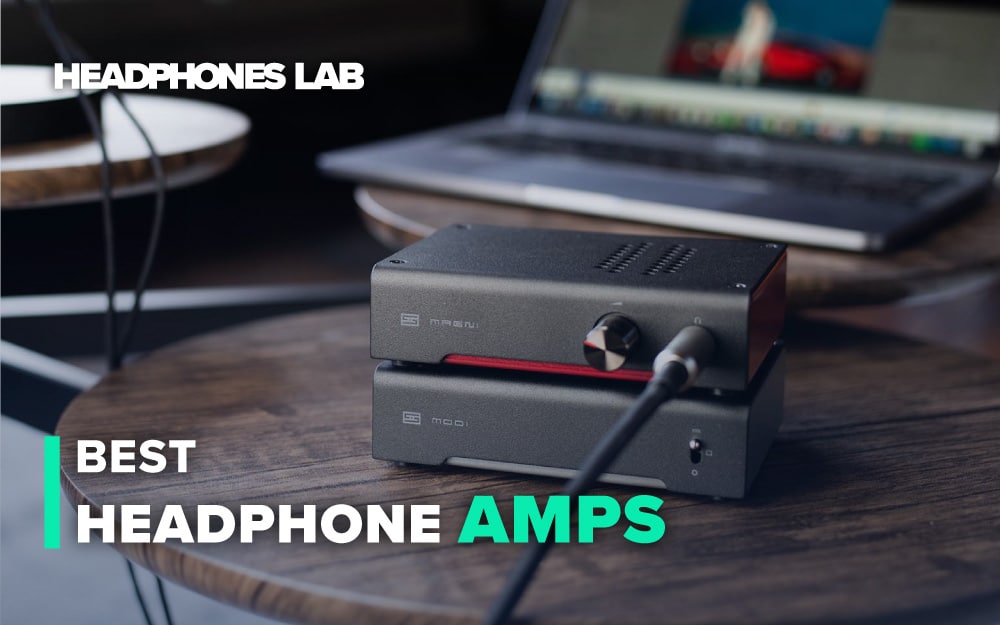Once upon a time, headphone amps and DACs were an absolute necessity not only for audiophiles but also for anyone who wanted decent audio quality as well. Nowadays, onboard sound cards are so good that we barely anyone needs such things. Long gone are the days where we needed great amps to bring out the full potential of our headphones – or are they?
If you know what impedance is on headphones, then you already know why this is not true. And if you don’t, well, keep on reading!
Things to Keep in Mind
First of all, let us mention that not everybody needs headphone amps. If you own a cheap set of cans with low impedance, chances are you’ll barely notice a difference with an amp – if any at all.
But, if you’ve got at least something like the ATH-M40x, HyperX Clouds/Trakstar, or a Sennheiser HD600, then you’ll most definitely notice a difference. And the higher than the impedance of your headphones is, the more noticeable that the difference will be.
With that out of the way, here are some things to keep in mind while checking out amps:
- Solid-state VS Valve: These are the two main kinds of amps that you’ll find. Both have their own pros and cons but Valves are still considered superior by enthusiasts
- Portability: Not all amps are portable. Some are too big and heavy or generally just not designed for portable use
- DAC integration: Some amps are actually hybrids as they include a built-in DAC. That can be very helpful if you don’t wish for a dedicated one or if you don’t like your onboard sound
- Sound: Amps will always affect the sound signature of your headphones. Some are more bassy while others try to provide a neutral experience
- Recommended impedance: Some amps are too “strong” for certain headphones at their lowest level and too “weak” to effectively power very high impedance ones
- Connectivity: The most common plug is 3.5mm. But, some amps come with 6.3mm, RCA or XLR as well. Make sure that you get the right adapters and that everything is compatible with your current equipment before taking the plunge and investing into a brand new amp
Our 5 Best Headphone Amps
This is more or less all you need to know in a nutshell. We’ll go into a bit more detail for some of those aspects in our reviews down below. So, without any further ado, let us check out some of the best amps!
1: Nobsound NS-08E
Best Budget Tube Headphone Amp (Hybrid)
Tube amps are usually expensive, heavy, and big. However, none of these attributes apply to the Nobsound NS-08E!
Type: Hybrid (Tube pre-amp/SS power)
Connectivity: 3.5mm in and out
DAC: No
Recommended impedance: 18-600 ohms
That’s mostly due to the fact that this is a hybrid – which means that it’s using tubes for the pre-amp section and a SS (Solid State) power section. This is good for obtaining tube “coloring” without making the amp big, expensive, and heavy.
Obviously, this isn’t going to sound anywhere near as good as a full-fledged tube amp that costs hundreds or even thousands of dollars. But, don’t forget the rule of diminishing returns. And also don’t forget that these offer great value.
The sound is honestly pretty decent for the money. If there’s one downside, then that’s going to be the fact that the included tubes are honestly not the best. Even a $10 upgrade is going to give you a noticeable increase in clarity.
If you’re new to tube/valve amplifiers, know that different tubes can give you different kinds of audio and clarity. Just make sure to buy the correct type.
One more thing that we like with this little amp is that it offers 3.5mm connectivity for both input and output. This makes things extremely easy as most of you won’t have to worry about finding the correct adapters and splitters in order to make it work – which is the case for most high-end amps.
Last, but not least, with an output of 1100mW at 32 ohms, this little beast can drive even some of the most demanding consumer-oriented headphones that are out there. Just keep in mind that it may be a bit too much for in-ears with extremely low impedance.
Pros:
- Very cheap
- Small
- 3.5mm connectors
- Can deliver a lot of power (especially for the money)
- Tube audio on the cheap
- Small
Cons:
- The included tubes could be better
- Not very portable (Tube amps and hybrids are generally much more fragile and harder to carry around)
2: Schiit Magni 3+
Best Affordable Solid State Headphone Amp
Tube amplifiers are still the superior choice for audio enthusiasts. But the truth is that solid-state amps have come a long way over the past few years. Not to mention that they come with a ton of advantages as well.
So, if you’re after a decent solid-state amp that’s not too expensive, we’d say that the Schiit Magni 3+ is definitely worth checking out!
Type: Solid state
Connectivity: RCA in and out with 3.5mm for headphones
DAC: No
Recommended impedance: 1-600 ohms
One of the first things to keep in mind is that the input is RCA. So, if you’re using onboard audio, a 3.5mm to RCA adapter is going to be essential.
Speaking of onboard audio, this amp doesn’t come with a DAC. But, considering how good it sounds for just a bit more than $100 and how easy it is to use, we’d say that it’s still a worthy investment. Just keep in mind that you may have to get a dedicated DAC in order to take full advantage of both the headphones and the amp itself.
In terms of power, this thing is pushing 2400mw into 32 ohms – which means that you should be able to power pretty much everything with it.
Since we’re looking at a solid-state amp, you should be able to carry this everywhere with relative ease. After all, there is no need to fear about breaking tubes and you certainly won’t have to worry about size and weight.
The gain modes at the back of it are a welcome addition since they allow us to switch between low and high output depending on the headphones that are plugged in. Small, in-ear monitors, for example, would most likely only work properly with a lower output since their impedance is very low.
Pros:
- Feels durable
- Great value
- Powerful
- 3.5mm port for headphones
- Low and hi-gain modes
- Great sound out of the box (Unless you have a bad sound card)
Cons:
- No DAC
- Only works with US 115V power (Could be usable in EU as well with a suitable power brick)
3: Audio Engine D1
DAC and Amp in One Package
We’ve already mentioned a couple of decent budget amps above. One of their biggest downsides, however, is that they don’t have a DAC. This isn’t a problem for those who already own one. But, if you don’t, then having to buy a dedicated DAC on top of a budget amp kind of decreases the value of the amp itself.
That’s why we decided to include a semi-affordable option that includes an amp as well!
Type: Solid state
Connectivity: USB Type-B, S/PDIF, RCA, 3.5mm on the front
DAC: Yes
Recommended impedance: 10-600 ohms
This is another solid-state amp – which means that you’re not getting the dynamics and warmth that tubes (and the transformer) provide. But, you do get a very solid amp, no pun intended, along with a DAC for less than $200. That’s a win in our book.
We like that there are a lot of options in terms of connectivity – but it’s also worth noting that the Type-B connector is a bit of a bummer. You’ll have a much rougher time finding a Type-B replacement rather than the “standard” USB cable that we all know and love.
That aside, we can hardly find any other downsides. There is good sound, a semi-affordable price tag, a durable build, lots of connectivity options, and plenty of power.
Pros:
- Includes a DAC
- Lots of connectivity options
- Durable build
- Works with all operating systems
Cons:
- The Type-B connector makes it harder to find compatible cables
4: AudioQuest Dragonfly Cobalt
Best Portable Headphone Amp
As we already mentioned, solid-state amps are generally easier and safer to carry around. However, most of them are still not the kind of thing that you’d be able to easily put in your pocket. Most amps are too large and too power-hungry to be used on the road.
Thankfully, there are still some options that are not just portable, but also very decent in terms of audio. AudioQuest’s Dragonfly Cobalt is currently one of the most popular options out there!
Type: Solid state
Connectivity: USB Type-A to 3.5mm
DAC: Yes
Recommended impedance: 16 and higher
One of the first things we noticed is that there is no recommendation for the highest headphone impedance. We assume that this is due to the fact that there is no external power for this DAC/amp and one would assume that it’s not going to be usable with very high-impedance headphones. But, thankfully, we were at least able to use with 250-300 ohm headphones without any issues.
Portability aside, if there’s one impressive thing about this mini amp, then that’s the fact that you can use it with smartphones as well. The only requirement is that your phone needs to support OTG technology and audio output through its port. That’s it. If you meet these requirements, just grab a Type-C (male) to USB Type-A (female) adapter and you should be good to go.
Just don’t forget that using this amp with a smartphone disables all in-line controls that your earbuds may have. That’s due to the fact that you’re not directly connecting them to the 3.5mm jack – which is a necessity for these controls to work.
Pros:
- Extremely portable
- DAC and amp in one package
- Very reliable
- Connectivity is as easy as it gets
- Works with portable devices
Cons:
- A bit expensive
- Questionable power limits due to USB power limitations
5: Schiit Valhalla 2
Best High-End Tube Amp
If you need a decent tube amp without venturing into enthusiast territory where you can easily spend thousands or even tens of thousands of dollars (Looking at you, Sennheiser), then the Schiit Valhalla 2 is definitely worth checking out.
Type: Tube
Connectivity: RCA input and output on the back – 3.5mm headphone jack at the front
DAC: No
Recommended impedance: 3.5-600 ohms
At this point, it’s worth noting that while many people claim tube sound to be objectively better, it also comes down to personal preference. Especially as far as “PC audio” is concerned. We’re not reviewing guitar amplifiers here.
All we’re trying to say is that this is a very good tube amplifier with “tube sound”. But, that doesn’t necessarily mean it’s objectively better than other solid-state amps at the same price point. So, we’d definitely encourage you to try out several amps before buying if you ever get the chance.
One thing that we liked with the Schiit Valhalla 2, apart from its sound, is the fact that it can also power low impedance headphones with its pre-amp section. This is rare for tube amplifiers as they are mainly made for high-impedance headphones like the HD 600s!
However, keep in mind that we still wouldn’t recommend this for low-impedance headphones and monitors. We’d say that a solid-state amp would be a better fit for them.
If there’s one downside, then that’s going to be the fact that it gets very hot. This is a common characteristic of tube amplifiers and nothing to worry about. Just try not to touch it and make sure to let it warm up for a few minutes before using it.
Pros:
- Great “tube sound”
- Two gain modes
- Feels very sturdy
- Lightweight and small (As far as tube amps are concerned)
- Technically works with both low and high-impedance headphones (Still not recommended for low impedance)
Cons:
- Expensive
- Gets very hot
- Can’t be used in EU and other regions that use the 220-240V standard
Headphone Amps: FAQ
SS VS Tubes VS Hybrids
There are mainly three types of amps:
- Solid-State
- Tube amps
- And hybrids
All of them have their own pros and cons. Solid-state amps are relatively new technology and rely on electrical components such as diodes and transistors in order to work. They are extremely reliable/durable, generally cheap, lightweight, and portable. And while we’ve seen massive improvements over the past two decades, many enthusiasts still prefer the dynamics and warmth of tube amps.
Tube amplifiers, or valve amplifiers, depending on where you’re from, rely on, well, old-fashioned tubes. Amplifying audio through tubes used to be our go-to choice for decades. However, since tube amps are generally more expensive, heavy, and more likely to break/need maintenance, solid-state amps slowly replaced them as the mainstream choice. Despite all that, tubes are still considered by many as the superior choice in terms of sound quality.
Hybrid amps are a mix of both. They use tubes in their pre-amp section for shaping the sound and solid-state power to amplify it. This gives you some of the audio characteristics that tube amplifiers come with while still remaining lightweight and relatively cheap. Just keep in mind that you still have to take care of the tubes.
What is Recommended Impedance?
Headphones, just like speakers, have a certain level of resistance to them. That’s what we call impedance.
The higher the impedance of your headphones, the harder that it’ll be to drive them effectively. Headphones with high levels of impedance like the very popular Sennheiser HD 600s (300 ohms) need a good dedicated amp or you’re just not taking full advantage of them.
Headphones and earbuds with very low resistance, on the other hand, are very easy to drive. However, you can also easily push them too much with powerful amps – which is why you generally don’t want to pair tube amps with low-impedance headphones.
What is a DAC?
DAC stands for Digital to Analog Converter and it’s exactly what it sounds. DACs are made to convert all the ones and zeroes of a digital file into analog sound and how they manage to do that can make a world of difference in how you perceive sound.
There are DACs that you can use in combination with amps and DACs that also act like amps. Usually, your best bet is to combine a very good DAC with a very good amp – but that’s also the most expensive route.
Wrapping Up
These are our top picks for now. To wrap things up as quickly as possible:
- Nobsound NS-08E: A great budget, hybrid amp. Its biggest downside is that it comes with mediocre-sounding tubes but you can easily replace them with something better on the cheap
- Schiit Magni 3+: All-around one of the best amps you can get without spending too much. If there’s one downside then that’s that it doesn’t work in countries with a 220-240V power rail
- Audio Engine D1: Great option if you want both a DAC and an amp in one package. Apart from the Type-B connector, we really don’t have any complaints with this one
- AudioQuest Dragonfly Cobalt: The best portable amp on this list. Just keep in mind that it’s a little bit expensive for what it offers and the lack of external power also worries us a bit
- Schiit Valhalla 2: A great tube amplifier with a price tag to match. The only downsides are that it’s expensive, it gets very hot, and just like with the Schiit Magni 3+, you can’t use it on countries with 220-240V rails
And that’s about it. If you have any more questions or if you want to recommend a different amp that we didn’t mention, feel free to let us know about it in the comments section!





